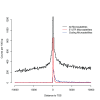Microsatellite tandem repeats are abundant in human promoters and are associated with regulatory elements
- PMID: 23405090
- PMCID: PMC3566118
- DOI: 10.1371/journal.pone.0054710
Microsatellite tandem repeats are abundant in human promoters and are associated with regulatory elements
Abstract
Tandem repeats are genomic elements that are prone to changes in repeat number and are thus often polymorphic. These sequences are found at a high density at the start of human genes, in the gene's promoter. Increasing empirical evidence suggests that length variation in these tandem repeats can affect gene regulation. One class of tandem repeats, known as microsatellites, rapidly alter in repeat number. Some of the genetic variation induced by microsatellites is known to result in phenotypic variation. Recently, our group developed a novel method for measuring the evolutionary conservation of microsatellites, and with it we discovered that human microsatellites near transcription start sites are often highly conserved. In this study, we examined the properties of microsatellites found in promoters. We found a high density of microsatellites at the start of genes. We showed that microsatellites are statistically associated with promoters using a wavelet analysis, which allowed us to test for associations on multiple scales and to control for other promoter related elements. Because promoter microsatellites tend to be G/C rich, we hypothesized that G/C rich regulatory elements may drive the association between microsatellites and promoters. Our results indicate that CpG islands, G-quadruplexes (G4) and untranslated regulatory regions have highly significant associations with microsatellites, but controlling for these elements in the analysis does not remove the association between microsatellites and promoters. Due to their intrinsic lability and their overlap with predicted functional elements, these results suggest that many promoter microsatellites have the potential to affect human phenotypes by generating mutations in regulatory elements, which may ultimately result in disease. We discuss the potential functions of human promoter microsatellites in this context.
Conflict of interest statement
Figures



 value is shown at the bottom of the figure. The largest scales were not included in this figure for simplicity.
value is shown at the bottom of the figure. The largest scales were not included in this figure for simplicity.
Similar articles
-
Abundance, arrangement, and function of sequence motifs in the chicken promoters.BMC Genomics. 2014 Oct 15;15(1):900. doi: 10.1186/1471-2164-15-900. BMC Genomics. 2014. PMID: 25318583 Free PMC article.
-
Some microsatellites may act as novel polymorphic cis-regulatory elements through transcription factor binding.Gene. 2004 Oct 27;341:149-65. doi: 10.1016/j.gene.2004.06.035. Gene. 2004. PMID: 15474298
-
STaRRRT: a table of short tandem repeats in regulatory regions of the human genome.BMC Genomics. 2013 Nov 15;14:795. doi: 10.1186/1471-2164-14-795. BMC Genomics. 2013. PMID: 24228761 Free PMC article.
-
Promoter microsatellites as modulators of human gene expression.Adv Exp Med Biol. 2012;769:41-54. doi: 10.1007/978-1-4614-5434-2_4. Adv Exp Med Biol. 2012. PMID: 23560304 Review.
-
Variable tandem repeats accelerate evolution of coding and regulatory sequences.Annu Rev Genet. 2010;44:445-77. doi: 10.1146/annurev-genet-072610-155046. Annu Rev Genet. 2010. PMID: 20809801 Review.
Cited by
-
Assembly of continuous high-resolution draft genome sequence of Hemicentrotus pulcherrimus using long-read sequencing.Dev Growth Differ. 2024 May;66(4):297-304. doi: 10.1111/dgd.12924. Epub 2024 Apr 17. Dev Growth Differ. 2024. PMID: 38634255 Free PMC article.
-
The Potential Role of Genic-SSRs in Driving Ecological Adaptation Diversity in Caragana Plants.Int J Mol Sci. 2024 Feb 8;25(4):2084. doi: 10.3390/ijms25042084. Int J Mol Sci. 2024. PMID: 38396759 Free PMC article.
-
Dyads of GGC and GCC form hotspot colonies that coincide with the evolution of human and other great apes.BMC Genom Data. 2024 Feb 21;25(1):21. doi: 10.1186/s12863-024-01207-z. BMC Genom Data. 2024. PMID: 38383300 Free PMC article.
-
Polygenic burden of short tandem repeat expansions promote risk for Alzheimer's disease.medRxiv [Preprint]. 2023 Nov 16:2023.11.16.23298623. doi: 10.1101/2023.11.16.23298623. medRxiv. 2023. PMID: 38014121 Free PMC article. Preprint.
-
Solution Structure of Poly(UG) RNA.J Mol Biol. 2023 Dec 15;435(24):168340. doi: 10.1016/j.jmb.2023.168340. Epub 2023 Nov 2. J Mol Biol. 2023. PMID: 37924862
References
Publication types
MeSH terms
Grants and funding
LinkOut - more resources
Full Text Sources
Other Literature Sources
Miscellaneous

